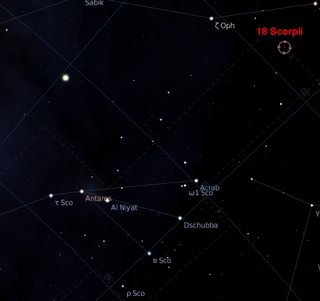18 Scorpii
|
Star 18 Scorpii |
|||||||||||||||||||||
|---|---|---|---|---|---|---|---|---|---|---|---|---|---|---|---|---|---|---|---|---|---|

|
|||||||||||||||||||||
| The red circle marks the location of 18 Scorpii in Scorpio. | |||||||||||||||||||||
| AladinLite | |||||||||||||||||||||
|
Observation dates equinox : J2000.0 , epoch : J2000.0 |
|||||||||||||||||||||
| Constellation | Scorpio | ||||||||||||||||||||
| Right ascension | 16 h 15 m 37.27 s | ||||||||||||||||||||
| declination | -08 ° 22 ′ 10 ″ | ||||||||||||||||||||
| Apparent brightness | 5.50 likes | ||||||||||||||||||||
| Typing | |||||||||||||||||||||
| B − V color index | +0.65 | ||||||||||||||||||||
| U − B color index | +0.17 | ||||||||||||||||||||
| R − I index | +0.33 | ||||||||||||||||||||
| Spectral class | G2 Va | ||||||||||||||||||||
| Astrometry | |||||||||||||||||||||
| parallax | (70.76 ± 0.11) mas | ||||||||||||||||||||
| distance | (46.06 ± 0.07) ly (14.13 ± 0.02) pc |
||||||||||||||||||||
| Visual absolute brightness M vis | +4.8 mag | ||||||||||||||||||||
| Proper movement | |||||||||||||||||||||
| Rec. Share: | (232.16 ± 0.18) mas / a | ||||||||||||||||||||
| Dec. portion: | (−495.37 ± 0.15) mas / a | ||||||||||||||||||||
| Physical Properties | |||||||||||||||||||||
| Dimensions | (1.01 ± 0.03) M ☉ | ||||||||||||||||||||
| radius | 1.02 to 1.03 R ☉ | ||||||||||||||||||||
| Luminosity |
1.08 L ☉ |
||||||||||||||||||||
| Effective temperature | 5800 K | ||||||||||||||||||||
| Metallicity [Fe / H] | approx. 0.02 (105% of the sun) |
||||||||||||||||||||
| Rotation time | 23 d | ||||||||||||||||||||
| Age | approx. 4 bill. a | ||||||||||||||||||||
|
Other names and catalog entries |
|||||||||||||||||||||
|
|||||||||||||||||||||
18 Scorpii , also known as HR 6060 , is a star about 45.7 light-years from the Sun, located in the northern part of the constellation Scorpio . It has many chemical and physical properties in common with the sun and is therefore also referred to in technical terms as solar twin ("sun twin"). Because of this similarity to the sun, some scientists believe that the prospects for life in its surroundings are good.
Characteristics
18 Scorpii is a main sequence star of the spectral class G2 Va. The metallicity of this main sequence star is about 1.05 to 1.12 times the metallicity of the sun.
According to Lockwood, 2002, the star shows photometric behavior that is very similar in time to the sun. However, the cycle of activity (according to Lockwood 2000) of 18 Scorpii has a greater amplitude and the total activity of the chromosphere is significantly greater than that of the sun. This excellent photometric twin could be a less perfect spectroscopic twin of the Sun.
18 Scorpii is a single star. It is currently unknown if it has planets. There is a good chance that gas giants orbit it at great distances, as is the case in the solar system. This would increase the likelihood of the existence of inner terrestrial planets .
Prospects for life
18 Scorpii was identified in September 2003 by astrobiologist Margaret Turnbull of the University of Arizona at Tucson as one of the most promising close candidates to harbor life. This rating was based on their HabCat list ("Catalog of Nearby Habitable Stellar Systems").
See also
Web links
Notes and individual references
- ↑ a b c d 18 Sco. In: SIMBAD . Center de Données astronomiques de Strasbourg , accessed February 2, 2019 .
- ↑ a b c Bright Star Catalog
- ↑ a b Porto de Mello and da Silva: HR 6060: The Closest Ever Solar Twin? . In: The Astrophysical Journal . 482, No. 2, 1997, pp. L89-L92.
- ↑ Cayrel de Strobel et al., 1991.
- ↑ GW Lockwood et al .: Gauging the Sun: Comparative photometric and magnetic activity measurements of sunlike stars, 1984-2001 . (PDF) In: Bulletin of the American Astronomical Society . 34, May 2002, p. 651.
- ↑ Jeffrey C. Hall and GW Lockwood: Evidence of a Pronounced Activity Cycle in the Solar Twin 18 Scorpii . In: The Astrophysical Journal . 545, No. 2, 2000, pp. L43-L45.